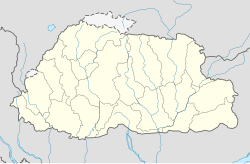| Nyimalung Monastery | |
|---|---|
| Religion | |
| Affiliation | Tibetan Buddhism |
| Sect | Nyingmapa |
| Location | |
| Location | Prakhar, Bhutan |
| Country | Bhutan |
| Coordinates | 27°29′50″N90°44′49″E / 27.49722°N 90.74694°E |
| Architecture | |
| Founder | Doring Trulku |
| Established | 1938 |
Nyimalung Monastery is a Buddhist monastery in central Bhutan, not far from Prakhar. The monastery was founded by Doring Trulku in 1938, a lama who originally came from Dartesedo in Kham in eastern Tibet. Jigme Wangchuck, the Second King of Bhutan, had the monastery renovated and upgraded in 1940. Then the monastery again underwent restoration in 2002. The monastery, home to around 150 monks is especially noted for its talented musicians and its large thangka, donated by the Japanese, which attracts pilgrims to a festival held from the 8th to the 10th day of the 5th lunar month. [1] [2]
